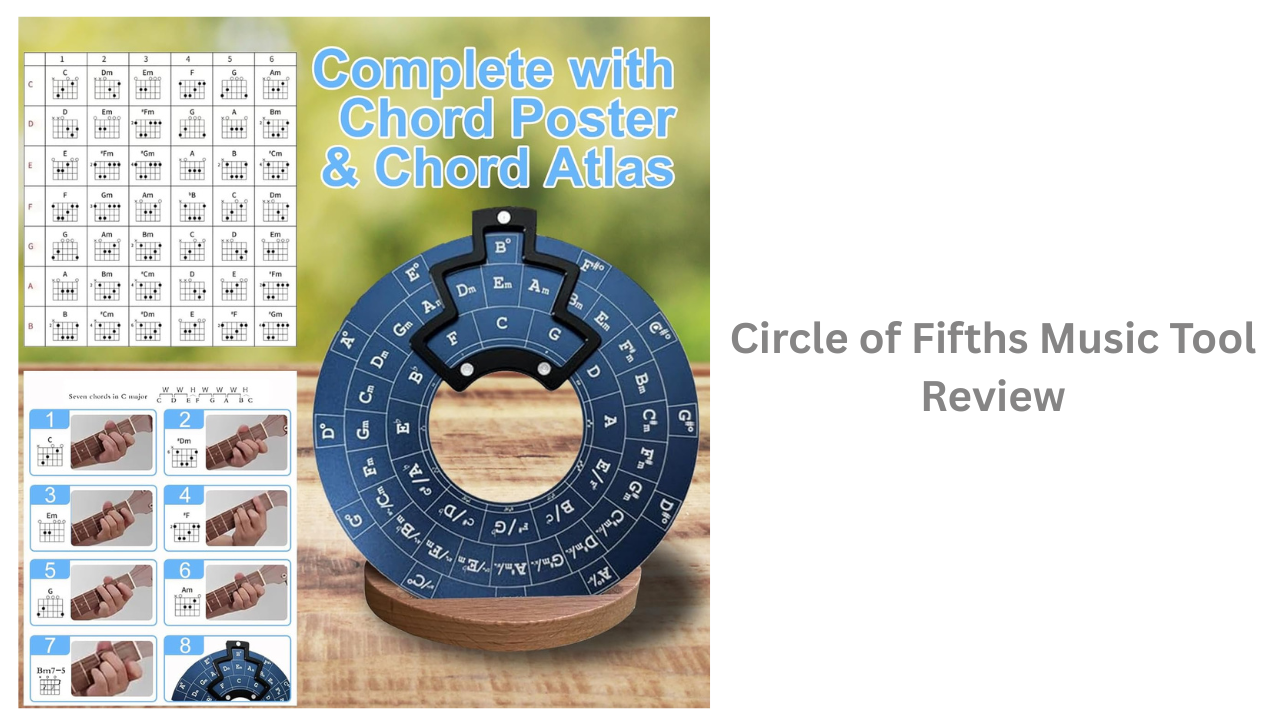For many budding musicians and seasoned songwriters alike, the Circle of Fifths represents both a fundamental theory tool and an enduring enigma. Enter the durable aluminum alloy Circle of Fifths Chord Wheel, complete with a wooden base, a detailed chord poster, and an atlas of chord progressions. Priced under twenty dollars, it promises to simplify key relationships, accelerate songwriting, and serve as a constant desktop companion. But does it live up to these lofty claims? In this review, we’ll explore its design, functionality, strengths, and limitations—so you can decide if (and when) this compact theory aid deserves a spot in your practice routine.
Design and Build Quality
At first glance, the chord wheel exudes robustness. Machined from aluminum alloy, the circular dial feels weighty in the hand, yet spins smoothly on its wooden pedestal. The tactile heft conveys a sense of longevity—no flimsy plastic here. Each key and its relative minor are laser-etched in crisp, white lettering against the metallic surface. A clear acrylic overlay protects the engravings from scratches during frequent use.
The accompanying wooden base is more than mere decoration. Its notch cradle holds the wheel at a comfortable viewing angle, and integrated slots accommodate up to three guitar picks or pencil tools. The natural wood grain contrasts nicely with the cool sheen of the metal, lending the piece an artisanal yet professional aesthetic. Overall, it feels like a studio-ready accessory rather than a student-grade gadget.
Core Features and Functionality
Intuitive Key Navigation
Central to the wheel’s appeal is how effortlessly it conveys key signatures. Rotate the outer ring to align any major key at the top, and its relative minor appears directly beneath. From there, adjacent keys represent perfect fifth relationships—ideal for crafting smooth modulations or authentic chord progressions. This visual shortcut eliminates the constant flipping through theory books, making it quicker to transpose a song into a friendlier vocal range or experiment with novel harmonic shifts.
Integrated Chord Poster and Atlas
Beyond the wheel itself, the package includes a fold-out chord poster that maps out extended chords, inversions, and common cadences. A complementary chord atlas breaks down popular progressions—think I–V–vi–IV in every key—so you can spark fresh songwriting ideas without starting from a blank page. Both resources are printed on glossy, tear-resistant stock, ensuring they survive frequent consultation by the piano or guitar stand.
Pick and Pencil Storage
Seemingly minor, the pick slots in the wooden base become surprisingly handy when you’re alternating between theory work and hands-on practice. There’s no scrambling for a spare pick when inspiration strikes; simply slide one in its groove and keep your hands free. The same applies to a pencil or stylus—perfect for jotting notes on lyric sheets or marking chord changes on sheet music.
Learning Curve and Usability
Though the wheel is straightforward, mastering its potential takes deliberate practice. Absolute beginners may need a primer on reading key signatures and understanding relative minors before the tool clicks. However, once you’ve internalized its wheel-and-spoke logic, the chord wheel becomes second nature—like glancing at a compass.
During testing, I found myself referring to it less frequently after a few weeks, as the visual link between adjacent keys became etched in memory. Songwriting sessions, in particular, benefited: instead of floundering through theory texts, I could freely twist the wheel to explore creative key changes and build harmonic depth on the fly.
Pros and Cons at a Glance
Pros:
- Sturdy Construction: Aluminum alloy wheel and solid wooden base feel built to last.
- Comprehensive Resources: Chord poster and atlas offer immediate songwriting guidance.
- Quick Key Reference: Instant visualization of key relationships accelerates transposition and modulation.
- Integrated Storage: Pick and pencil slots keep essential tools within arm’s reach.
- Aesthetic Appeal: Elegant mix of metal and wood doubles as decorative studio decor.
Cons:
- Price vs. Alternative Formats: Under twenty dollars is reasonable, but free smartphone apps can replicate circle-of-fifths functions.
- Single Fixed Size: The six-inch diameter may be too small for easy readability from a distance.
- Limited to Diatonic Theory: Users seeking modal or jazz-centric theory tools may outgrow it.
Who Stands to Benefit Most
- Songwriters and Arrangers: Anyone crafting original music will appreciate the rapid access to common progressions and key shifts.
- Music Educators and Students: Teachers can demonstrate relationships visually, while students reinforce theory concepts without flipping pages.
- Multi-Instrumentalists: Pianists, guitarists, and bassists can all reference the same wheel, encouraging group practice and collaborative composition.
- Home Studio Enthusiasts: The wheel’s elegant look makes it a fitting accessory beside keyboards and mixing consoles—both functional and decorative.
Less likely to invest are casual hobbyists who prefer tab-focused learning or players who rely solely on ear-training and improvisation. If you’re deep into jazz extensions, microtonal scales, or atonal music, you may find this tool too diatonic-centric.
When to Bring It Home
- Curriculum Kick-Off: Perfect timing at the start of a music theory course or songwriting workshop.
- Holiday or Graduation Gift: An inspired present for a student, teacher, or any musician at a pivotal learning stage.
- Studio Refresh: When your creative space feels uninspiring, this tactile aid can reignite curiosity and exploration.
- Gear Minimalism: Ideal for those downsizing from bulky theory tomes but unwilling to sacrifice hands-on visual tools.
Final Verdict
The aluminum alloy Circle of Fifths Chord Wheel with its wooden base, chord poster, and atlas strikes a compelling balance between form and function. It elevates a core music-theory concept into a tangible, interactive experience that can spark both learning and creativity. While smartphone apps may offer similar digital convenience, nothing quite matches the immediacy of twisting a metal wheel under your fingertips.
Priced affordably and built to last, this tool is best suited for those serious about understanding key relationships and crafting polished chord progressions. If you’re ready to invest in a hands-on approach to theory—and appreciate fine studio decor—this chord wheel could be the catalyst that transforms your next songwriting session.
mrsuggest.online is a participant in the Amazon Services LLC Associates Program, an affiliate advertising program designed to provide a means for sites to earn advertising fees by advertising and linking to Amazon.com and affiliated sites.
As an Amazon Associate, we earn from qualifying purchases. This means that some of the links on our website are affiliate links, and if you click on them and make a purchase, we may receive a small commission — at no additional cost to you.
We only recommend products that we genuinely believe will add value to our visitors. All reviews and opinions expressed on this website are our own.



